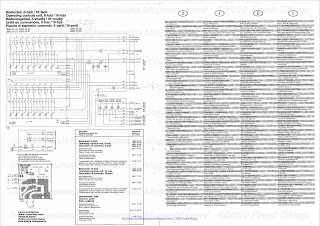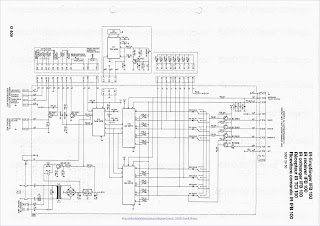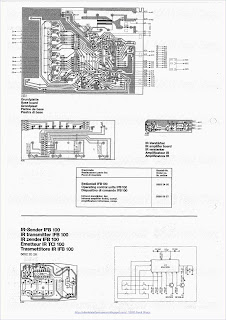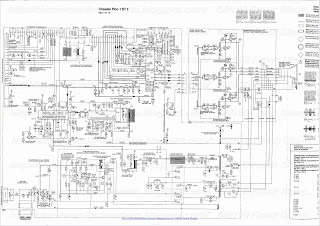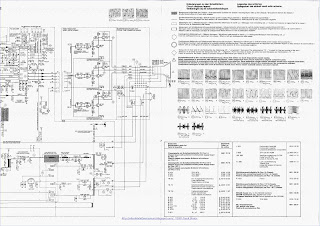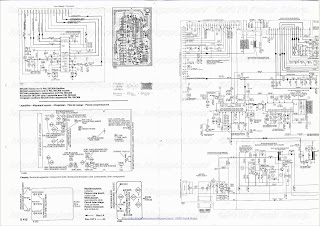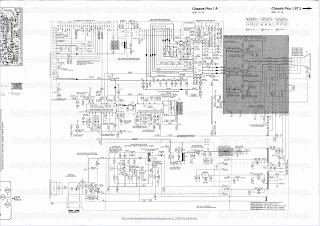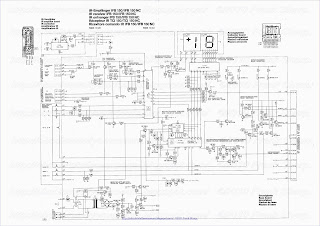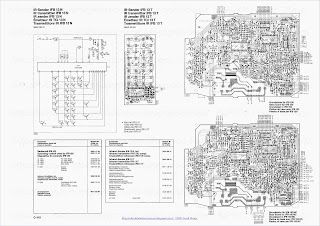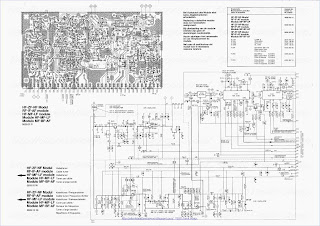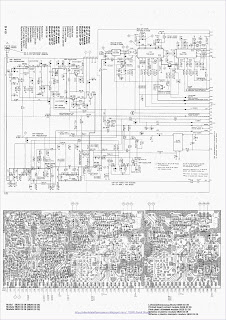The ITT IDEAL COLOR 3214 OSCAR is a 15 inches portable color television with 16 programs KEYBOARD selection and potentiometric tuning search.
- The mechanical turret approach to television tuning has been used almost exclusively for the past 60 years. Even though replete with the inherent disadvantages of mechanical complexity, unreliability and cost, such apparatus has been technically capable of performing its intended function and as a result the consumer has had to bear the burdens associated with the device. However, with the " recent " Broadcast demands for parity of tuning for UHF and VHF channels, the increasing number of UHF and cable TV stations have imposed new tuning performance requirements which severely tax the capability of the mechanical turret tuner. Consequently, attempts are now being made to provide all electronic tuning to meet the new requirements.
The invention relates to a tuning unit with bandswitch for high frequency receivers, especially radio and television receivers, having a potentiometer system for the control of capacity diodes, the said potentiometer system consisting of a plurality of parallel resistance paths along which wiper contacts can be driven by means of screw spindles disposed adjacent one another in a common insulating material housing in which a bandswitch formed of metal rods is associated with each tuning spindle.
In these tuning units, the working voltages of the capacity diodes in the tuning circuits are recorded once a precise tuning to the desired frequency has been performed. A potentiometer tuning system has great advantages over the formerly used channel selectors operating with mechanically adjustable capacitors (tuning condensers) or mechanically adjustable inductances (variometers), mainly because it is not required to have such great precision in its tuning mechanism.
Tuning units with bandswitches formed of variable resistances and combined with interlocking pushbuttons controlling the supply of recorded working voltages to capacity diodes are known. Channel selection is accomplished by depressing the knobs, and the tuning or fine tuning are performed by turning the knobs. The resistances serving as voltage dividers in these tuning units are combined into a component unit such that they are in the form of a ladderlike pattern on a common insulating plate forming the cover of the housing in which the tuning spindles and wiper contacts corresponding to the variable resistances are housed. The number of resistances corresponds to the number of channels or frequencies which are to be recorded. The wiper contact picks up a voltage which, when applied to the capacity diodes determines their capacitance and hence the frequency of the corresponding oscillating circuit. The adjustment of the wipers is performed by turning the tuning spindle coupled to the tuning knob. By the depression of a button the electrical connection between a contact rod and a tuning spindle is brought about and thus the selected voltage is applied to the capacity diodes. Since the push buttons release one another, it is possible simply by depressing another button to tune to a different receiving frequency or a different channel, as the case may be.
Moreover, using this arrangement, the only indication--during adjustment--of which channel is selected is by station identification.
In the end of the 60's 70's increasingly attention was focused on the varicap diode tuner as the latest, sophisticated means of television receiver frontend tuning in both colour and black and white sets.
The tuning has a manual AFC red button to deactivate it during search.
The general concept of Automatic Frequency Control (AFC) for television receivers is known in the art and has been adapted to radio receivers as well as to television receivers of both the monochrome and color variety. The general purpose of such a system is to assist the user in attaining proper fine-tuning of the receiver without requiring critical manual adjustment. The advantage of such a system is self-evident but its value to a color receiver is markedly increased due to the fact that improper tuning of a color receiver manifests itself in incorrect colors, or even a total lack of color, in the reproduced image.
Typically, the AFC system is tuned to a reference or center frequency corresponding to the desired video IF frequency and so long as the tuning is reasonably close, within the response of the AFC system, an error voltage is developed to correct the tuning. If the user of the television receiver makes the fine-tuning adjustment while the AFC system is operative, he may adjust it to a point where the picture is acceptable but a substantial amount of AFC correction voltage is required. Thus, the receiver may be tuned at the limit of the "hold-in" range and would not give the proper "pull-in" performance when the channel selector is switched to the next channel. Accordingly, it is desirable to include an AFC defeat circuit for disabling the AFC system during manual fine-tuning. Heretofore, most AFC defeat circuits have required that the user of the television receiver defeat the AFC system by means of a manual switch. It is apparent, however, that the typical user of a television receiver may at times forget to flip the switch and hence the attendant problems are realized.
- The set features a black matrix color picture tube.This invention relates to a black matrix color picture tube and a method for its fabrication and particularly to a high-contrast black matrix color picture tube and a method for its fabrication.
The phosphor screen of a so-called black matrix color picture tube has on its faceplate the formation of a nonluminous, light-absorptive powder layer (black matrix) for partly covering the phosphor layer so that the phosphor layer appears through aperture sections (matrix holes). A method of reducing the inner surface reflection has been proposed, in which a material having virtually the same refractivity as the faceplate material, e.g., water glass, is filled in the gap between the faceplate and the black matrix layer. See, for example, JP-A-57-115749.
A black matrix color picture tube has a phosphor layer and black matrix layer formed on the inner surface of the faceplate. A layer of glass having a low softening point is provided between the phosphor layer and the inner surface of the faceplate and between the black matrix layer and the inner surface of the faceplate. The softening point of the glass is below the temperature at which the tube is subjected during a frit baking step employed in the fabrication of the tube. For example, a borophosphate glass is used as the layer of glass having a low softening point.
- Above the program selection keyboard manual controls for volume,brightness,contrast,color saturation with slide potentiometers.
- The set was featuring the PICO 1A chassis allowing the fitting of a integrated TV Color chassis in little dimensions comprising all functions of the receiver having the legacy with very bigger types fitted in earlier models.
- Was first ITT Portable color television featuring the PHILIPS TDA3560A a decoder for the PAL colour television standard. It combines all functions required for the identification and demodulation of PAL signals.
Furthermore it contains a luminance amplifier, an RGB-matrix and amplifier.
- Above a hand grip is present and a pair of expandable telescopic antennas.
NO SCART connector is present.
Pictures are EXCELLENT !!.................Sound too.
----------------------------------------------------------------------------
ITT Corporation (NYSE: ITT) is a global diversified manufacturing company with 2008 revenues of $11.7 billion. ITT participates in global markets including water and fluids management, defense and security, and motion and flow control. Forbes.com named ITT Corporation to its list of "America's Best Managed Companies" for 2008, and awarded the company the top spot in the conglomerates category.

,ITT's water business is the world's largest supplier of pumps and systems to transport, treat and control water, and other fluids. The company's defense electronics and services business is one of the ten largest US defense contractors providing defense and security systems, advanced technologies and operational services for military and civilian customers. ITT's motion and flow control business manufactures specialty components for aerospace, transportation and industrial markets.
In 2008, ITT was named to the Dow Jones Sustainability World Index (DJSI World) for the tenth time in recognition of the company's economic, environmental and social performance. ITT is one of the few companies to be included on the list every year since its inception in 1999.
The company was founded in 1920 as International Telephone & Telegraph. During the 1960s and 1970s, under the leadership of its CEO Harold Geneen the company rose to prominence as the archetypal conglomerate, deriving its growth from hundreds of acquisitions in diversified industries. ITT divested its telecommunications assets in 1986, and in 1995 spun off its non-manufacturing divisions, later to be purchased by Starwood Hotels & Resorts Worldwide.
In 1996, the company became ITT Industries, Inc., but changed its name back to ITT Corporation in 2006.
History
ITT was formed in 1920, created from the Puerto Rico Telephone Company co-founded by Sosthenes Behn.
Its first major expansion was in 1923 when it consolidated the Spanish Telecoms market into what is now Telefónica.[
From 1922 to 1925 it purchased a number of European telephone companies. In 1925 it purchased the Bell Telephone Manufacturing Company of Brussels, Belgium, which was formerly affiliated with AT&T, and manufactured rotary system switching equipment. In the 1930s, ITT grew through purchasing German electronic companies Standard Elektrizitaetsgesellschaft (SEG) and Mix & Genest, both of which were internationally active companies. Its only serious rival was the Theodore Gary & Company conglomerate, which operated a subsidiary, Associated Telephone and Telegraph, with manufacturing plants in Europe.
In the United States, ITT acquired the various companies of the Mackay Companies in 1928 through a specially organized subsidiary corporation, Postal Telegraph & Cable. These companies included the Commercial Cable Company, the Commercial Pacific Cable Company, Postal Telegraph, and the Federal Telegraph Company.
International telecommunications
International telecommunications manufacturing subsidiaries included STC in Australia and Britain, SEL in Germany, BTM in Belgium, and CGCT and LMT in France. Alec Reeves invented Pulse-code modulation (PCM), upon which future digital voice communication was based. These companies manufactured equipment according to ITT designs including the (1960s) Pentaconta crossbar switch and (1970s) Metaconta D, L and 10c Stored Program Control exchanges, mostly for sale to their respective national telephone administrations. This equipment was also produced under license in Poznań (Poland), and in Yugoslavia, and elsewhere. ITT was the largest owner of the LM Ericsson company in Sweden but sold out in 1960.
1989 breakup
In 1989 ITT sold its international telecommunications product businesses to Alcatel, now Alcatel-Lucent. ITT Kellogg was also part of the 1989 sale to Alcatel. The company was then sold to private investors in the U.S. and went by the name Cortelco Kellogg. Today the company is known as Cortelco (Corinth Telecommunications Corporation, named for Corinth, MS headquarters). ITT Educational Services, Inc. (ESI) was spun off through an IPO in 1994, with ITT as an 83% shareholder. ITT merged its long distance division with Metromedia Long Distance, creating Metromedia-ITT. Metromedia-ITT would eventually be acquired by Long Distance Discount Services, Inc. (LDDS) in 1993. LDDS would later change its name to Worldcom in 1995.
In 1995, ITT Corporation split into 3 separate public companies:
* ITT Corp. — In 1997, ITT Corp. completed a merger with Starwood Hotels & Resorts Worldwide, selling off its non-hotel and resorts business. By 1999, ITT completely divested from ITT/ESI; however, the schools still operate as ITT Technical Institute using the ITT name under license.[1] Also in 1999, ITT Corp. dropped the ITT name in favor of Starwood.
* ITT Hartford (insurance) — Today ITT Hartford is still a major insurance company although it has dropped the ITT from its name altogether. The company is now known as The Hartford Financial Services Group, Inc.
* ITT Industries — ITT operated under this name until 2006 and is a major manufacturing and defense contractor business.
o On July 1, 2006, ITT Industries changed its name to ITT Corporation as a result of its shareholders vote on May 9, 2006.
Purchase of International Motion Control (IMC)
An agreement was reached on June 26, 2007 for ITT to acquire privately held International Motion Control (IMC) for $395 million. The deal was closed and finalized in September 2007. An announcement was made September 14, 2010, to close the Cleveland site.
Purchase of EDO
An agreement was reached September 18, 2007 for ITT to buy EDO Corporation for $1.7 billion. After EDO shareholders' approval, the deal was closed and finalized on December 20, 2007.
Purchase of Laing
On April 16, 2009, ITT announced it has signed a definitive agreement to acquire Laing GmbH of Germany, a privately held leading producer of energy-efficient circulator pumps primarily used in residential and commercial plumbing and heating, ventilating and air conditioning (HVAC) systems.
2011 breakup
On January 12, 2011, ITT announced a transformation to separate the company into 3, stand-alone, publicly-traded, and independent companies.
HISTORY OF Standard Elektrik Lorenz AG IN GERMAN:
Die Standard Elektrik Lorenz AG (heute Alcatel-Lucent Deutschland AG) ist ein Unternehmen der Nachrichtentechnik (früherer Slogan: SEL – Die ganze Nachrichtentechnik) mit Hauptsitz in Stuttgart. Zur Nachrichtentechnik zählen auch Informations- und Kommunikationstechnik, Telekommunikationstechnik (SEL war für die Röchelschaltung bekannt) und früher Fernmeldetechnik oder Schwachstromtechnik. Einen weiteren Geschäftsbereich hatte das Unternehmen in der Bahnsicherungstechnik, so wurden für die Deutsche Bundesbahn Relaisstellwerke und elektronische Stellwerke mit den dazugehörigen Außenanlagen (Signale, Gleisfreimeldeanlagen, Weichenantriebe) sowie die Linienzugbeeinflussung entwickelt und gebaut, welche auch bei ausländischen Bahnen Abnehmer fanden. Der Bereich gehört seit 2007 als Thales Transportation Systems GmbH (seit 02.2011 vorher Thales Ra
 il
Signalling Solutions GmbH) zum Thales-Konzern. Die bereits 1998
ausgegliederten Bereiche Alcatel Air Navigation Systems und SEL
Verteidigungssysteme sind ebenfalls heute in Thales
Deutschland beheimatet.
il
Signalling Solutions GmbH) zum Thales-Konzern. Die bereits 1998
ausgegliederten Bereiche Alcatel Air Navigation Systems und SEL
Verteidigungssysteme sind ebenfalls heute in Thales
Deutschland beheimatet.Fernseher Illustraphon 743 von 1957
„Goldsuper Stereo 20“ (1961)
Das Flaggschiff der erfolgreichen Schaub-Lorenz Kofferradios der sechziger Jahre: Touring 70 Universal
Erster Digitalfernseher der Welt (1983)
Bis 1987 gehörte SEL zusammen mit anderen auf dem Sektor Telekommunikation in anderen Ländern tätigen Schwesterfirmen zum US-amerikanischen Mischkonzern International Telephone and Telegraph (ITT). ITT verkaufte die Aktien-Mehrheit an den ITT-Telekommunikationsfirmen an die französische Compagnie Générale d’Electricité (CGE), die nach der Zusammenfassung mit den eigenen Telekommunikationsaktivitäten daraus die Alcatel N.V. bildete.
Die Standard Elektrik Lorenz AG wurde 1993 in Alcatel SEL AG umbenannt. Die Aktienmehrheit liegt mit über 99 % bei der Alcatel. Mit der Fusion von Alcatel und Lucent zu Alcatel-Lucent am 1. Dezember 2006 und der Neu-Firmierung beider Unternehmen in Deutschland zur Alcatel-Lucent Deutschland AG entfiel der Zusatz SEL.
Geschichte
Die beiden Stammfirmen des Unternehmens
 , die Mix & Genest AG und
die Telegraphenbauanstalt von C. Lorenz, wurden 1879 bzw. 1880
gegründet. Das erste Patent von Mix & Genest datiert
von 1883, das erste Patent von C. Lorenz ist aus dem Jahr 1902.
, die Mix & Genest AG und
die Telegraphenbauanstalt von C. Lorenz, wurden 1879 bzw. 1880
gegründet. Das erste Patent von Mix & Genest datiert
von 1883, das erste Patent von C. Lorenz ist aus dem Jahr 1902.Das Unternehmen Mix & Genest war wesentlicher Teil der Standard Elektrizitäts-Gesellschaft (SEG), in die auch die Süddeutsche Apparatefabrik (SAF), die 1875 von F. Heller als "Friedrich Heller, Fabrik Elektrotechnischer Apparate" gegründet wurde, integriert wurde. Der technische Schwerpunkt von Mix & Genest bzw. SEG sowie der C. Lorenz AG war der klassischen Fernmelde- bzw. Funktechnik zuzuordnen. Die C. Lorenz AG baute in den 1920er und 1930er Jahren Großsender für den neu gegründeten Rundfunk.
1930 übernahm die International Telephone and Telegraph Company (ITT) die Aktienmehrheit der Mix & Genest AG und der C. Lorenz AG.
Die C. Lorenz AG positionierte sich mit der Übernahme der G. Schaub Apparatebau-Gesellschaft mbH im Jahr 1940 in der Entwicklung und Herstellung von Rundfunkempfängern. Ab dem Jahr 1950 wurden alle Geräte bei Schaub in Pforzheim gefertigt. 1952 wurde das Typenprogramm beider Unternehmen verschmolzen und der Lorenz-Radio-Vertrieb in die Firma Schaub integriert. Ab 1955 wurden die Geräte unter dem Namen Schaub-L
 orenz vertrieben.
orenz vertrieben.1956 wurde das Unternehmen SEG in Standard Elektrik AG umbenannt. Ebenfalls 1956 wurde ein Kabelwerk gegründet. Wesentlicher Motor für das 1957 gegründete Informatikwerk war Karl Steinbuch, der von 1948–1958 dem Unternehmen, zuletzt als Technischer Direktor und Leiter der Zentralen Forschung, angehörte.
1958 erfolgte die Vereinigung der Standard Elektrik AG mit der C. Lorenz AG zur Standard Elektrik Lorenz AG (SEL).
Die Standard Elektrik Lorenz AG übernahm 1961 die Graetz KG. Die Firmenteile Schaub-Lorenz und Graetz waren zusammen mit einem Bildröhrenwerk Bestandteil der Unternehmensgruppe Audio Video der SEL AG, die 1979 als Audio-Video-Elektronik in die ITT ausgegliedert wurde. Die Produkte, die unter anderem Fernsehgeräte, Radios, Autoradios, Kassettenrecorder, Weltempfänger und Lautsprecherboxen umfassen, wurden fortan unter dem Namen ITT Schaub-Lorenz vertrieben.
 Versuche, auf dem neuen Gebiet der Raumfahrt-Elektronik Fuß zu fassen, waren auf folgende Produkte beschränkt:
Versuche, auf dem neuen Gebiet der Raumfahrt-Elektronik Fuß zu fassen, waren auf folgende Produkte beschränkt:* AZUR: Telemetrie/Telekommandogeräte
* Spacelab: Datenerfassung/Kommandoterminal.
SEL entwickelte zu Beginn der 1970er Jahre das Präzisionsanflugverfahren SETAC. Dieser Unternehmensbereich wurde im Jahre 1987 von der finnischen Firma Nokia übernommen.
1976 hatte SEL ein Grundkapital von 357 Mio. DM bei 33.000 Beschäftigten und einem Umsatz von 2,6 Mrd. DM.
2003 wurden die Markenrechte am Namen Schaub Lorenz an die italienische General Trading SpA verkauft. Die neugegründete Schaub Lorenz International GmbH vertreibt seitdem unter dem alten Markennamen Schaub-Lorenz importierte Konsumelektronik aus dem unteren Preisbereich.
References:
Demerjian, Dave (25 October 2007). "As Skies Grow Crowded, FAA Preps Air Traffic Control 2.0". Wired.com. Archived from the original on 14 June 2013. Retrieved 25 May 2013.
"ITT Corporation 2017 Annual Report Form (10-K)" (XBRL). United States Securities and Exchange Commission. February 14, 2018.
"ITT Corporation 2016 Annual Report Form (8-K)" (XBRL). United States Securities and Exchange Commission. February 14, 2017. Archived from the original on March 16, 2017.
"ITT History". ITT Inc. Archived from the original on 2017-08-03. Retrieved 2017-08-02.
"At A Glance | ITT Inc". www.itt.com. Retrieved 2019-01-09.
www.itt.com https://www.itt.com/CMSPages/GetFile.aspx?guid=10cffa55-7c3c-4e27-b649-d0378feddc07. Retrieved 2019-01-09. Missing or empty
|title= (help)
"ITT to break itself up, fueling share rally". Reuters. January 12, 2011. Archived from the original on July 1, 2012. Retrieved July 14, 2011.
Jacobs, Karen (July 14, 2011). "UPDATE 1-ITT sets names for planned spin-offs". Reuters. Archived from the original on July 1, 2012. Retrieved July 14, 2011.
Sobel, Robert (2000). ITT: The Management of Opportunity. Beard Books. pp. 35ff.
Macintosh, Norman B.; Paolo Quattrone (2009). Management Accounting and Control Systems. John Wiley and Sons. pp. 155–6.
Ingham, John N. (1983). Biographical dictionary of American business leaders, Volume 1. Greenwood Publishing Group. pp. 62–4.
Sampson, Anthony. The Sovereign State of ITT, Hodder and Stoughton, 1973. ISBN 0-340-17195-2
Garcia Algarra, Javier (2010). "The American influence in Telefónica's public relations strategy during the 20s and 30s" Archived 2013-06-01 at the Wayback Machine, IEEE HISTELCON 2010
AMERICAN VISITS HITLER. Behn of National City Bank Confers With Chancellor in Alps. New York Times, 1933-08-04, "Archived copy". Archived from the original on 2014-03-07. Retrieved 2013-05-16.
»Empfänge beim Reichskanzler«, Vossische Zeitung, Berlin 1933-08-04, Abendausgabe, Seite 3, "Archived copy". Archived from the original on 2014-03-07. Retrieved 2013-05-03.
The Office of Military Government US Zone in Post-war Germany 1946-1949, declassified per Executive Order 12958, Section 3.5 NND Project Number: NND 775057 by: NND Date: 1977
Leidig, Ludwig. Bombshell. sbpra, 2013 ISBN 978-1-62516-346-2
Farnsworth, Emma. "Farnsworth, Philo T. and Elma G." J. Willard Marriott Library, University of Utah. Archived from the original on 14 July 2014. Retrieved 8 July 2014.
"KONI shock absorbers". Archived from the original on 2015-05-18.
International Telephone and Telegraph Corporation Archived 2012-01-22 at the Wayback Machine at Funding Universe
Knippers Black, Jan (1977). United States Penetration of Brazil. The University of Pennsylvania Press. pp. 40–49.
Langguth, A. J. (1979). Hidden Terrors: The Truth about U.S. Police Operations in Latin America. New York: Pantheon Books.
Green, James (2010). We Cannot Remain Silent: Opposition to the Brazilian Military Dictatorship in the United States. Durham and London: Duke University Press. p. 89. ISBN 978-0-8223-4735-4.
Burn Before Reading, Admiral Stansfield Turner, 2005, Hyperion, pg. 99. Also see the article on Humberto de Alencar Castelo Branco. Also see BRAZIL MARKS 40th ANNIVERSARY OF MILITARY COUP Archived 2008-11-20 at the Wayback Machine, National Security Archive, George Washington University. Edited by Peter Kornbluh, 2004.
Ancona, Vincent S. (Fall 1992). "When the Elephants Marched out of San Diego". Journal of San Diego History. San Diego Historical Society. 38 (4). Archived from the original on 2013-07-05.
"ITT: No charges". Time Magazine. June 10, 1974. Archived from the original on 19 October 2012. Retrieved 24 October 2012. United States and American History: 1972 Archived 2007-03-18 at the Wayback Machine at trivia-library.com
Hinchey Report Archived 2009-10-20 at the Wayback Machine at US Dept. of State
Stout, David (January 30, 2003). "Edward Korry, 81, Is Dead; Falsely Tied to Chile Coup". The New York Times. Archived from the original on May 12, 2013. Retrieved May 5, 2010.
The Pinochet File: How U.S. Politicians, Banks and Corporations Aided Chilean Coup, Dictatorship Archived 2015-09-12 at the Wayback Machine. Democracy Now! September 10, 2013.
Montgomery, Paul L. (September 29, 1973). "I.T.T. OFFICE HERE DAMAGED BY BOMB; Caller Linked Explosion at Latin-American Section to 'Crimes in Chile' I.T.T. Latin-American Office on Madison Ave. Damaged by Bomb Fire in Rome Office Bombing on the Coast Rally the Opponents". The New York Times. Archived from the original on May 12, 2011. Retrieved May 5, 2010.
Ayers, Bill. Sing a Battle Song: The Revolutionary Poetry, Statements, and Communiques of The Weather Underground
Wasserstein, Bruce. Big deal: the battle for control of America's leading corporations
Associated Press (23 November 1997). "Obituary: Harold Geneen, 87; Led ITT's Growth for 18 Years". The New York Times. Archived from the original on 27 March 2016.
Viswanathan, T. Telecommunication Switching Systems and Networks, p.225.
US Patent 4,201,891 at freepatentsonline.com
International Telephone Telegraph Corp at encyclopedia.com
Magnet, Myron; Andrew Evan Serwer (11 November 1985). "IS ITT FIGHTING SHADOWS -- OR RAIDERS?". Fortune. Archived from the original on 29 April 2014.
Chapuis, Robert J.; Joel, Amos E., Jr. "IX-7: "The ITT (now Alcatel) System 12"". 100 Years of Telephone Switching.
"ITT Earnings Decline 33% for 3rd Quarter" Archived 2011-12-24 at Wikiwix, Los Angeles Times, 5 November 1985.
Bartlett, Christopher A.; Ghoshal, Sumantra (2002). Managing Across Borders (2 ed.). Harvard Business School Press. ISBN 978-1-57851-707-7.
ITT Telecom Archived 2016-12-20 at the Wayback Machine, The New York Times, 26 June 1984.
"ITT Makes Sale To Southern Bell" Archived 2016-12-20 at the Wayback Machine, The New York Times, 21 March 1985.
ITT System 12 Archived 2016-09-20 at the Wayback Machine at frankoverstreet.com
Hinman, Catherine."ITT Division In Brevard Will Furlough 60" Archived 2011-12-23 at Wikiwix, Orlando Sentinel, 14 March 1986.
Alcatel-Lucent Timeline Archived 2012-02-03 at the Wayback Machine at alcatel-lucent.com
Alcatel SA Company History Archived 2012-01-22 at the Wayback Machine at Funding Universe
"ITT Accepts $3.6 Billion Alcatel Sale" Archived 2016-03-06 at the Wayback Machine, The New York Times, 4 March 1992.
"Archived copy". Archived from the original on 2016-09-08. Retrieved 2016-09-13. ITT Tech closes its doors, blaming ‘unconstitutional’ US sanctions
"COMPANY NEWS; Metromedia Deal For 2 ITT Units" Archived 2017-12-19 at the Wayback Machine, The New York Times, 16 March 1989.
"Company News; Starwood Lodging in $2.1 Billion Deal with Vnu". The New York Times. 1997-12-19. ISSN 0362-4331. Retrieved 2018-05-29.
Webpage at ITTESI.com Archived October 22, 2006, at the Wayback Machine
Nunez, Michael (September 6, 2016). "ITT Tech Is Officially Closing". Gizmodo. Archived from the original on September 6, 2016. Retrieved September 6, 2016.
Center, Arbitration and Mediation. "WIPO Domain Name Decision: D2001-0166". Archived from the original on 2001-06-10.
Lindsey, Sue. "ITT Fined $100M for Illegal Tech Exports"[dead link], Associated Press, March 27, 2007.
Cullen, Drew. "ITT Fined for Illegal Exports" Archived 2011-02-24 at Wikiwix, The Register, 27 March 2007.
"Consent Agreement, 2007: ITT Corporation" Archived 2009-10-10 at the Wayback Machine U.S. State Department, 2007.
"ITT fined $100 million for illegal exports". CNN. 27 March 2007. Archived from the original on 28 March 2010. Retrieved May 5, 2010.
"ITT Corp. Acquires EDO in $1.7B Deal". Archived from the original on 2016-08-17.
"Archived copy". Archived from the original on 2011-09-23. Retrieved 2009-01-03. 67 (block): The International Telephone and Telegraph Building, erected in 1928 by Garment District developer Abraham Lefcourt as the Lefcourt Exchange Building, was almost immediately bought by ITT--which expanded the building to take over the whole block by 1930.
Holusha, John. "Commercial Property /75 Broad Street; Turning Buildings Into Telecommunications Hubs" Archived 2016-03-16 at the Wayback Machine, The New York Times, 10 October 1999.
http://www.thecityreview.com/parkave.html. Archived from the original on 2012-01-20. Missing or empty
|title= (help)
Deutsch, Claudia H. (21 May 1989). "REFORGING THE 'GENEEN MACHINE'". The New York Times. Archived from the original on 28 August 2016.
"International Telephone & Telegraph ITT Information and History". Archived from the original on 2016-03-29.
"Radio Tower Demolished". The New York Times. 5 April 1996. Archived from the original on 22 July 2010. Retrieved 2010-07-23.
"ITT Avionics Gets $19.6M Air Force Pact". Bergen Record. 19 September 1991. Archived from the original on 18 May 2013. Retrieved 2010-07-23.
(August 20, 2004.) "ITT Industries Receives Contract for $24.9 Million." Archived 2012-04-20 at the Wayback Machine Impeller.net Archived 2011-11-01 at the Wayback Machine. Accessed November 2011.
(in German) https://blogger.googleusercontent.com/img/b/R29vZ2xl/AVvXsEhnKTQ77fJC1zPOqLucj9Ld9DOZoteOPpCdq21SAyBjdDgHDWGgFfxgS6C__apBgbZyyouh4vXtL2fUJUK8DWbrPlzriwCroyMR-ci_t_9Ti3Yf5vGJw-jrBSZV7J8LsyvLEYYfGm61RkUU/s1600/ITT-2805_SLK-AD2.jpg. Archived from the original on 2018-05-01. Missing or empty
|title= (help)
"Consola "pong" Tele-Match (versión con paddle) (1977)". retroordenadoresorty.blogspot.it (in Spanish). Archived from the original on 1 May 2018. Retrieved 14 February 2018.
"ITT DIGIVISION 3447 OSCAR YEAR 1986". Obsolete Technology Tellye. Retrieved 14 February 2018.
"Kellogg Switchboard & Supply Co". Dictionary of Leading Chicago Businesses. Archived from the original on 18 August 2015. Retrieved 15 February 2018.
"Über ITT - ITT". www.itt-deutschland.de (in German). Archived from the original on 17 October 2017. Retrieved 15 February 2018.
"Nokia Announces Final Sale of its Television Manufacturing Business - Nokia". Nokia. Archived from the original on 2017-07-29.
"Über Karcher - ITT". www.itt-deutschland.de (in German). Archived from the original on 22 December 2016. Retrieved 14 February 2018.
R.I.P. EUROPE !
























